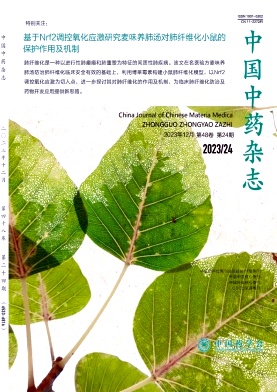This study used Caco-2 cells and normal rats to investigate the in vitro absorption characteristics and in vivo pharmacokinetic characteristics of cannabidiol(CBD) and explore the anti-inflammatory mechanism of CBD. The safe concentration range of CBD was determined by the CCK-8 assay, and then the effects of time, concentration, temperature, endocytosis inhibitors, and transport inhibitors on the transepithelial absorption and transport of CBD were assessed. The blood drug concentration was measured at different time points after oral administration in rats for pharmacokinetic profiling, and the pharmacokinetic parameters were calculated. The Caco-2 cell model of inflammation injury was established with lipopolysaccharide(LPS). The effects of CBD on lactate dehydrogenase(LDH) activity, transendothelial electrical resistance(TEER), and levels of inflammatory cytokines of the modeled cells were exami-ned, on the basis of which the anti-inflammatory mechanism of CBD was deciphered. The results showed that within the concentration range tested in this study, the CBD uptake by Caco-2 cells reached saturation at the time point of 2 h. Moreover, the CBD uptake was positively correlated with concentration and temperature and CBD could be endocytosed into the cells. CBD could penetrate Caco-2 cells through active transport pathways involving multidrug resistance-associate protein 2(MRP2) and breast cancer resistance protein(BCRP), while the addition of P-gp inhibitors had no effect on CBD transport. Rats exhibited rapid absorption of CBD, with the peak time(t_(max)) of(1.00±0.11) h, and fast elimination of CBD, with a half-life(t_(1/2)) of only(1.86±0.16) h. In addition, CBD significantly ameliorated the increased LDH activity and decreased TEER that were caused by inflammatory response. It maintained the intestinal barrier by down-regulating the expression of pro-inflammatory cytokines interleukin-8(IL-8), interleukin-1 beta(IL-1β) and tumor necrosis factor-α(TNF-α), thus exerting anti-inflammatory effects.
| 公司名称 | 产品信息 | 采购帮参考价格 | |
|---|---|---|---|
| 阿拉丁 | 氯丙嗪 |
|
¥72.00~¥100000.00 |
| 阿拉丁 | KO-143 |
|
¥238.00~¥16641.00 |
| 阿拉丁 | 苯海拉明 |
|
¥23.00~¥13020.00 |
| 阿拉丁 | 维拉帕米 |
|
¥190.00~¥12451.00 |
| 索莱宝 | 青链霉素混合液 |
|
|
| 索莱宝 | PBS缓冲液 |
|
|
| 索莱宝 | 细胞培养级DMSO |
|
|
| 索莱宝 | 胰蛋白酶-EDTA消化液 |
|


